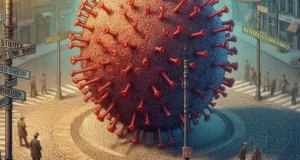If history were a river, winding through time and geography, then Kinshasa—the heart of the Democratic Republic of Congo—would be one of its most powerful bends. But hidden beneath its vibrant life lies a shadow that stretches across continents and decades.

“AIDS – where did it come from?”
To answer this question, we must trace our steps not just into the forests where the virus first jumped species, but into the heart of Kinshasa, the city that unknowingly became the epicenter of the first HIV outbreak.
In the early 1900s, Kinshasa—then known as Léopoldville—was transforming from a colonial post into a bustling urban center. Railways connected the inland forests to the coast. Trade boomed. People from across Central Africa poured into the city in search of work and opportunity. With them came goods, stories, and—unbeknownst to all—viruses.
Among these was HIV, which had evolved from SIV, a virus found in chimpanzees. As previous stories told, the likely crossover happened during the bushmeat trade, when hunters came into contact with chimpanzee blood. But that was only the spark. The fire—the actual spread—needed fuel. And Kinshasa provided exactly that.
The city, growing rapidly, faced the same challenges of many developing urban centers: overcrowding, poor sanitation, and limited medical oversight. In this chaos, HIV found its fertile ground. Medical practices of the time often reused syringes, and blood transfusions lacked proper screening. Sex work flourished along transportation hubs.

Genetic studies later traced multiple early strains of HIV-1 back to Kinshasa. Samples collected in the 1950s and 60s showed the virus already spreading among the population. Yet the world remained unaware. The virus slipped silently from one person to another, crossing borders without passports, language, or noise.
By the time AIDS was recognized in the United States in the early 1980s, HIV had already left Kinshasa and traveled the globe. It moved down rivers and over roads, hitching rides with migrants, travelers, and trade. It passed through cities that never questioned its presence, until it began taking lives at an alarming rate.
So, when someone asks “AIDS – where did it come from?”, the answer is layered. It began with a chimpanzee, passed to a hunter, and then found momentum in Kinshasa—a city that became, unknowingly, ground zero.
But Kinshasa’s role is not one of blame—it is one of understanding. The city stands as a symbol of how interconnected health and human movement truly are. It’s a reminder that pandemics do not just emerge from biology, but from geography, history, and the flow of people.
Kinshasa’s story teaches us that disease often spreads not in loud eruptions, but in quiet ripples—through train stations, hospital corridors, and crowded neighborhoods. HIV wasn’t born in Kinshasa, but it was amplified there.
Today, scientists continue to study Kinshasa’s early role in HIV’s emergence—not to rewrite blame, but to understand how to prevent such outbreaks in the future. And as we reflect on the question, “AIDS – where did it come from?”, Kinshasa remains a key chapter in that narrative—a city where silence once screamed beneath the surface.




